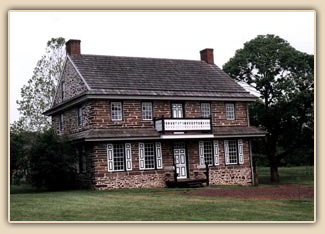 The Peter Wentz House in Montgomery County, PA. The exterior was originally painted in an intriguing color combination of black and white.
The Peter Wentz House in Montgomery County, PA. The exterior was originally painted in an intriguing color combination of black and white.
|
The Peter Wentz House was built in 1758 by Peter Wentz, Jr. The building structure presents an unusual combination of a Georgian central hall plan with other architectural elements of German influence. Its historical significance is enhanced by the fact that George Washington twice used the farmstead as his headquarters, lodging there while planning strategies for the Battle of Germantown.
Now owned by Montgomery County, the house was restored in 1975-76 under the direction of architect John D. Milner. The chosen period of interpretation was 1777, corresponding to the year of Washington's visits. During his investigation, Welsh discovered bold and colorful sponge-painting and brushed decoration on many of the house's plaster walls and dadoes. After working to uncover the original finishes, Welsh documented and illustrated the findings in an article in the APT Bulletin (vol. 7, no. 2, 1975). He collaborated with paint chemist A. Richard Fitch to formulate paints with historically accurate colors and textures. All original decorations were executed in calcimine paints and whitewashes. Welsh restored the decorative painting throughout the house, leaving several protected sections of original painted decoration visible as a historic record.
The restoration of the Peter Wentz House brought attention to the unexpectedly bright and vibrant nature of the blue, yellow and reddish brown colors used in 18th century American interior decoration. The nature of the original finishes and Welsh's recreation of the sponge painting gained notoriety through additional publications about the project in American Antiques, The Magazine Antiques, House and Garden and Colonial Design in the New World. In 1979, the Pennsylvania Historical & Museum Commission named this restoration one of the top three restorations in the state
|
